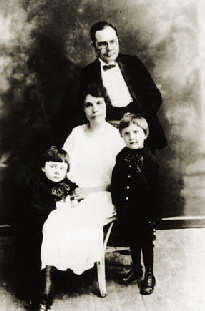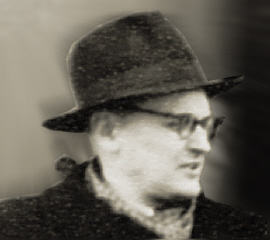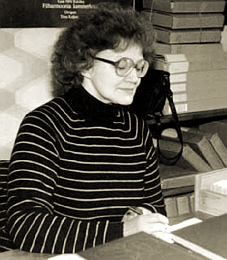Linda Dégh
Source: American Folklore and the Mass
Media. Bloomington & Indianapolis: Indiana University Press 1994, pp. 80-109.
1st edition: Fabula 1989, vol. 30, pp. 43-62.
Mare Kõiva
The English version of this article cf.
Folklore. An Electronic Journal of Folklore 2002, vol. 21.
Triinu Ojamaa
The Englisch version of this article cf.
Folklore. An Electronic Journal of Folklore 2002, vol. 21.
Brigitte Boenisch-Brednich
The English version of this article cf.
Folklore. An Electronic Journal of Folklore 2002, vol. 20.
Tõnno Jonuks
Descriptions of sagas have been widely used in studies on prehistoric and early medieval periods but mostly as descriptive sources. The following article will discuss Scandinavian sagas, written mostly during the 13th and the 14th centuries, and will attempt to analyse how the Scandinavians and especially Icelandic saga-writers have understood the eastern Baltic region, namely Estonia, Latvia and the area known as Austrvegr. The latter is a relatively ambiguous term and has been used only in texts describing the eastern Baltic in regard to the context.
The article distinguishes between the two different levels of attitude towards the inhabitants of the area under discussion. The first attitude that was widespread and shared mostly by ordinary people describes the Eastern Baltic as a balanced area with common culture. Several paragraphs contain references to the Scandinavian names given to the Estonians, or information about the etymology of toponyms. But there was also another level, which shows the eastern Baltic region as different, strange and hostile. According to these descriptions Austrvegr was inhabited by giants and other evil creatures, against whome men had to fight. It is also distinctive that most of these stories appear in the later, the so-called Knight sagas.
This may be explained by the fact that the sagas were scribed
by Christian monks in the monasteries of Iceland. The written
stories were old and passed down orally, thus representing the first,
i.e. the common level of attitude. The second attitude was
probably represented by monks, who regarded the eastern Baltic as a
heathen region, and not a part of the Christian world. According to the
Old Norse worldview, which was probably still followed, among
others, also by the monks, evil beings inhabited a region
somewhere east and north of the World of Men. So the eastern Baltic
proved very appropriate as a supposed dwelling place. And it was also
much easier to integrate these artificial stories into later sagas,
which were actually European tales of chivalry, originally not
associated with the world of the sagas.
Anu Vissel
Cyrillus Kreek (1889-1962) was a leading promoter of the Estonian choir music (also a well-known composer, conductor and music teacher), whose work focused largely on ethnomusicology. His interest in folk music lasted from his university years to the age of a mature scholar. The present article discusses C. Kreek's contacts with the Estonian Swedes and their folk music, which have previously been overshadowed by the Estonian folk music in the earlier studies on the composer's works. Shedding light on these aspects helps to explain the composer's interest towards the collection of the Swedish folk music in 1921, at the time, when the collection of the Estonian tradition was a priority in folklore. The article is divided in three subchapters: Cyrillus Kreek and the collection of the Estonian folk music; Cyrillus Kreek, the Läänemaa County and the coastal Swedes; and on the 1921 collection expedition of Cyrillus and Maria Kreek among the Estonian Swedes.
C. Kreek joined the collection team of the Estonian folk tunes (the head of the team, which was active during 1904-1916, was Oskar Kallas) only in 1911, but he quickly became an enthusiastic collector. It is worth noting that he was successful also in Läänemaa County in western Estonia, which was considered somewhat problematic because of the numerous religious movements and sects in the region. Apart from having good communicative skills and a witty sense of humour, he was successful in establishing good contacts with his informants also due to the popularity of his father, a lifelong school teacher in the region. In 1914 C. Kreek was the first Estonian to use phonograph in folkloric collection work. The period of wars in 1915-1919 (the First World War, the War of Independence) interrupted the collection work. For him, the 1921 collection expedition remained the last expedition that was organised and financed by the Estonian academic and education circles. His later, self-initiated recordings of folk tunes were made in Rakvere and Haapsalu. During 1923-1932, while working as a music teacher in the Läänemaa Teachers' Seminar, his students helped him with the collection work. C. Kreek's total contribution was approximately 1300 recordings of folk tunes. After the 1930s he copied folk tunes from the folklore archives in Tartu and the materials collected by his acquaintances for personal use. His personal collection of folk tunes consists of nearly 6000 recordings.
Läänemaa County was the home of C. Kreek and of many
generations of his ancestors. Cyrillus Kreek himself lived there
for most of his life, including the period of professorship at the
Tallinn Conservatory. In his youth he was actively involved in the
music life of the county, organising concerts, the Läänemaa song
festivals, etc.

The Swedes have lived on the western coast and the islands of Estonia since the 13th century. The native Estonians call this ethnic group rannarootslased, or the coastal Swedes. By the end of the 19th and the beginning of the 20th century, the Estonian areas with the densest population of the Swedes were the islands of Ruhnu (Runö), Vormsi (Ormsö), Osmussaar (Odensholm), Pakri (Stora och Lilla Ragö), and the Noarootsi (Nuckö) peninsula. According to the 1934 census the number of Swedes in Estonia was 7641 (including 5600 Swedes in Läänemaa).
C. Kreek's acquaintance with the Estonian Swedes began in his childhood in 1896, when his father started working as a teacher at the Fällarna School on the Swedish-populated island of Vormsi (Ormsö). There he also made acquaintance with the Swedish language. The Swedish ties became tighter in 1918, when Cyrillus Kreek married an Estonian-Swede Maria Blees (1893-1988), who was also a teacher and spoke her mother tongue, Russian, German and Estonian. They had two sons: Peeter (1919-1934) and Toor (1920 - 1995) (see Photo 2, pp. 149). C. Kreek participated in various cultural events of the Estonian-Swedes; among other things, he was also the chief coordinator of the first Swedish song festival in 1933, he has adapted the old choral of the Estonian Swedes Den signade dag (`This Blessed Day') to the mixed choirs (see Photo 5, pp. 161).
In summer 1921 C. Kreek was once again in Läänemaa County, collecting folk music. This time he intended to collect the Estonian folk music, and also the musical heritage of the Estonian Swedes. (His made his first attempts already in 1915 in the Alliklepa village, Risti parish, inhabited mostly by the descendants of the Estonians and the Swedes.) He was supposed to remain to the Noarootsi peninsula only for the first half of the collection expedition, and spend the second half in the Estonian-populated parishes on the western coast of Estonia and on the island of Hiiumaa (Dagö). To guarantee the linguistic accuracy of the Swedish folk songs, he had invited along his wife Maria to interpret and write down the words. They spent most of the time on the Noarootsi peninsula, because contagious diarrhoea epidemic broke out on the continent in June. Their return to the Noarootsi peninsula enabled them to conduct a gleaning collection. This, again, was disrupted when their home caught fire. In spite of all, C. Kreek managed to visit 21 villages and record 163 tunes (111 of them as audio recordings) with his two colleagues. On this expedition trip he was interested in the popular performance of church chorals, both by the Estonians and the Swedes, and used phonograph for observing this song genre only (the only exception here is the performance of a Gate Game in Estonian, collected from Ridala). 50 of the collected 55 Swedish songs are choral tunes, whereas most of them are recorded in variants performed by different singers. The collector studied the variation of choral tunes on the level of the performer, family, and the ethnic group. To facilitate the observance of choral tune variation, the collector has arranged the tune variants to a single `score' (see sample 4, where the upper tune is written down by ear, the lower from a phonograph recording). As the collection was mainly intended for an Estonian reader, the Estonian songs corresponding to the Swedish chorals and the Estonian translations of song texts have been included (see Photo 4, pp. 157-158).
In 1934 C.Kreek's son Peeter died at the age of 15. Five years later the Kreeks divorced; the other son, Toor, stayed to live with his mother and was mobilised by the German Army during the World War II. Maria Kreek returned to her ethnic homeland in 1944 together with her fellow Estonian Swedes. Soon after his divorce, Cyrillus Kreek married an elementary school teacher Aleksandra Tinski (1909-1989), and had three children with her: Anne (1940), Maria (1941-2001) and Jüri (1944). Regardless of the complicated political situation, the paths of Toor and his father and his new family crossed again later in Sweden (see Photo 6, pp. 163).
During the periods 1940-1941 and 1944-1950 Cyrillus Kreek worked as a professor of music theory at the Tallinn Conservatory. In 1950, when most of the earlier Estonian intelligentsia was labelled `bourgeois nationalists', professor Kreek was forced to "voluntarily" resign from his post for "not meeting the qualifications, neither professional nor ideological, required for a work at a higher education school".
C. Kreek was undoubtedly the paramount expert and the
most prolific collector of the folk tunes of western Estonia. Among
his contributions to the music (being a composer, choir conductor,
music teacher and a collector of folk tunes at the
ethnomusicologist level) was also the collection of the religious folk tunes of the
Estonian Swedes. Collecting the heritage of a foreign ethnic group
is difficult unless the collector is fully familiar with it. C. Kreek
was guided by his own experience with the Estonian Swedes as well as
a competent companion and assistant - his then-wife Maria Kreek.
Kristi Salve
Though Paul Ariste had extensive knowledge of different living, extinct and artificial languages, he has always regarded his mother tongue, the Estonian language, the most beautiful language in the world. He managed to instil this conviction also into his students, both Estonian and of other, mostly Finno-Ugric, origin.
The Vepsian folklore and language remained in the periphery
of Paul Ariste's research subjects: his serious interest in the
language and cultures may have prompted his inclination towards the
non-Estonian folklore while working at the Estonian Folklore
Archives. On his initiative, although by the consent of Oskar Loorits,
PhD and the first head of the Estonian Folklore Archives, separate
collections were established on the folklore material of the ethnic
minorities then living in Estonia and of other peoples, mostly
the Balto-Finns. A smaller collection (ERA, Mitmesugused rahvad)
also includes material on the Vepsian folklore.

Paul Ariste was once asked to collect sayings related to breaking a tooth from as many ethnic groups as possible. This work resulted in his first records on the Vepsian folklore.
A few years later, while leading the field work expeditions of the students of the Tartu University in 1953, 1954, 1955 and 1961, P. Ariste's work on recording the Vepsian folklore expanded. Material collected on these expeditions, constituting more than 400 pages, was contributed to the collection of the then Chair of Finno-Ugric Languages and were destroyed in the 1965 fire at the main building of the University of Tartu.
Fortunately, a small part of the collection made its way to the Estonian Literary Museum, and is preserved in the catalogue RKM, Soome-ugri 2, containing mostly folk songs from the central Vepsia, but also folk tales. P. Ariste has also published some of the Vepsian folk tales he collected ("Vepsa muinasjutte" [The Folk Tales of the Veps], Tallinn 1964). This was also his only publication solely on the Vepsian material. The Folk Tales of the Veps contains six tales with a translation into Estonian, and an extremely laconic summary in Russian, covering less than a quarter of a page, as well as a preface. His appeal to pay more attention to the Vepsian folklore was heard.
Paul Ariste's greatest contribution to the study of the Veps,
both folklore and language, was his work at educating new
generations of researchers of the Vepsian folklore.
Eda Kalmre
Jan Harold Brunvand has been the leading researcher of
contemporary urban folklore since his 1981 The Vanishing
Hitchhiker. Presently Professor Emeritus at the University of Utah,
Brunvand has extensively collected urban folklore and scraps of media,
which may likely become folklore. He has also published, categorised
and explained numerous folklore texts on the subject, but has still
remained true to the comparative-historical approach. His work under discussion, The Truth Never Stands in the Way of a Good
Story contains 13 chapters discussing specific narrative plots, including
a chapter by the pre-eminent folklorist's son Eric Brunvand, an
information technologist.
 Runic Song is Estonian Poetry, Too
Runic Song is Estonian Poetry, Too
Karin Maria Rooleid
Interview with Ruth Mirov on the occasion of her 75th anniversary.
The interview touches on her activities as a folklorist and
literary critic. As a researcher of folklore and literary fiction,
R. Mirov states her view: in runic songs, the word is primary -
runic song is part of Estonian poetry. The interview also includes
information about past eras, scientific policies and the educational
situation.
News, overviews
 Asta Õim 60
Asta Õim 60
Rein Saukas
Asta Õim, one of the most reputable lexicographers and phraseologists in Estonia, the senior researcher at the folklore department of the Estonian Literary Museum, PhD in philology, and the directress of the Estonian Language Institute in 1994-2000, celebrated her 60th birthday.
Her dictionaries of synonyms
[Sünonüümisõnastik, 1991],
antonyms
[Antonüümisõnastik, 1995] and phraseology
[Fraseoloogiasõnaraamat, 1993, 2000] are increasingly used as reliable
sources of reference. Rein Saukas presents a summary of Asta Õim's
invaluable contribution.
Ethnologist Marika Mikkor has used traditional comparative
historical method in her thesis Muutuvast
matusekombestikust kaukaasia eestlastel, ersamordvalastel ja
isuritel [On the Transformation of Funeral Tradition among the Estonians in
the Caucasus,the Erza-Mordvins and the Izhorians], and has covered
an extensive body of comparative material of our neighbouring and
kindred peoples in search for parallels. An overview by Marju
Torp-Kõivupuu.
on Tanatology
Argo Moor's doctoral thesis Dialoog surmaga
- seosed uskumuste, suhtumiste ja moraali vahel
[A Dialogue with Death: Relating Beliefs, Attitudes and
Ethics], is a unique study into the subject related
to death within the Estonian-speaking cultural area, focusing mainly
on the ethics behind this topic. An overview of the thesis by Toomas Liiv.
the biographical songs of the Setu women
Folklorist Andreas Kalkun's master's thesis
Seto naiste eluloolaulud. Autobiograafiad ja
utoopiad [The Biographical Songs of the Setu Women. Autobiographies and Utopias], is noteworthy in its
valuable insight into the runic songs tradition of the Setu and
the worldview of the Setu female singers in the early 20th
century. Kristiina Ehin provides a summary of the thesis.
Tõnno Jonuks has reached several important results in his
extensive master's thesis Eesti muinasusundi põhijooni
metalliajal [Principles of Pre-Christian Religion in Estonia during the Metal
Ages]: the author has (i) established substantial grounds
for reconstructing the evolution of the ancient religion of the Metal Ages in Estonia;
(ii) reasoned the stages of development of the religion and described
the changes at different stages; (iii) presented convincing evidence
on the Germanic-Scandinavian influence on the Estonian religion
during the different periods of the Metal Ages; and (iv) been the first
to rightly suggest the idea of collective spirit (Germ.
Sippenseele) and sacral kingship. An overview of the thesis by Tarmo Kulmar.
Piret Õunapuu, researcher at
the-, Estonian National Museum, provides a detailed overview of the foundation, development and
formation during the period of two decades (1909-1928) in her thesis
Eesti Rahva Muuseumi vanem ajalugu [The Earlier History of the
Estonian National Museum]. Comments on the thesis by Ants Viires.
The Anthology of Estonian Traditional Music on CD presents
115 music pieces, focusing on the folklore genre of
regilaul [runic song]. An overwiew by Janika Oras.
The Eesti murdeplaat [Estonian dialect CD] (Tallinn: Eesti Keele Sihtasutus 2003) is educational material for pupils - a combination of audio material, text and illustrations. An overview by Jüri Viikberg.
Estonian language on CD
An overview of the recent Estonian language material on CD
by Jüri Viikberg.
An overview of the international performance project "Prince
Betelgeuze, Princess Algieba and Princess Bellatrix Travel Around
the Baltic Sea" by Kaarina Ormio (Finland) in co-operation with
Jaan Pärnamäe (Estonia) and Elin Tanding Sørensen (Norway). An
overview by Kalmer Kand.